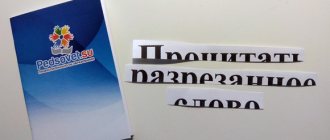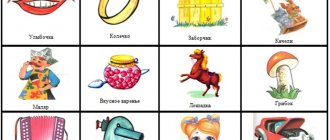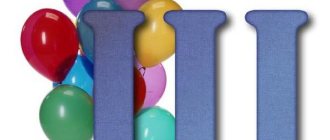Learning to read syllables - this stage in teaching children to read is one of the most important and difficult. Often parents simply don’t know how to teach their child to pronounce two letters together and get “stuck” on this for a long time. Tired of the endless repetition of “ME and A will be MA,” the child quickly loses interest, and learning to read turns into torture for the whole family. As a result, children who already know letters from the age of two or three, even by the age of five cannot read simple words, not to mention reading sentences and books.
What to do next when the child remembers the letters? Let’s immediately make a reservation that teaching a preschooler to read syllables can begin BEFORE he has mastered the entire alphabet (moreover, some teachers insist that you need to move on to syllables as quickly as possible, without waiting for all the letters to be learned). But the child must name the letters that we will combine into syllables without hesitation.
In order to begin learning to read syllables, a child only needs to know 3-4 vowels and several consonants. First of all, take those consonants that can be drawn out (S, Z, L, M, N, V, F), this will help teach the child how to pronounce the syllable together. And this is a fundamentally important point.
So, let's look at several, in our opinion, the most effective methods that modern teachers offer for teaching a child to form letters into syllables.
Let's play "Trains"
(game from the manual by E. Baranova, O. Razumovskaya “How to teach your child to read”).
Instead of boring cramming, invite your child to “ride the train.” All the consonants are written on the rails on which our trailers will travel, and the vowels are written on the trailers themselves. We place the trailer on the rails so that a consonant appears in the window, and name what station we have (for example, BA). Next, we move the trailer down the rails until the next consonant and read the syllable that appears.
There is a similar manual in the cards “Train Engine Game”. We read the syllables." from E. Sataeva
This game is good because the child does not need to be specifically explained how to add syllables. It is enough to say: “Now we will ride the letter A, it will be our passenger, name all the stations where we will stop.” First, “take a ride” yourself - let the child move the trailer along the rails, and you loudly and clearly call the “stations”: BA, VA, GA, DA, ZHA, ZA, etc. Then invite your child to do this with you in turn. During the game, listening to you, children easily grasp how to pronounce two sounds together. The third time, the child can “ride” himself without much difficulty.
If the child does not know all the letters, stop only at those “stations” that are familiar to him. Next we change the trailer. Now we roll the letters O, U, Y. If the child copes with the task easily, we complicate the task. For example, we go for a speed ride, timing which of the trailers will get to the end of the journey first. Or another option: when stopping at a station, the child must name not only the syllable, but also the words starting with this syllable (BO - barrel, side, Borya; VO - wolf, air, eight; GO - city, golf, guests; DO - rain, daughter, boards, etc.).
Please note that with this game you can practice reading not only open syllables (with a vowel at the end), but also closed ones (with a consonant at the end).
To do this, we take the trailers where the vowels are written in front of the window, and proceed in the same way. Now we have a letter on the trailer, not the passenger, but the driver, she is the main one, she is in front. First, read the resulting “stations” with closed syllables yourself: AB, AB, AG, AD, AZ, AZ, etc., then offer the child a “ride.”
Remember that in this and other exercises we first practice adding syllables with vowels of the first row (A, O, E, U, Y), and then introduce vowels of the second row (Ya, Yo, E, Yu, I) - so-called “iotated” vowels, which make the sound preceding them soft.
When the child is good at reading individual tracks with syllables, alternate the carriages with passengers and drivers, without telling which carriage we will be rolling. This will help the child learn to clearly see where exactly the vowel is in a syllable (the syllable begins or ends with it). At the first stages of learning to read syllables, a child may have difficulties with this.
How to teach a child to read syllables so that he likes it?
If your child already knows letters, but doesn’t want to learn to read syllables, most likely, you simply haven’t explained why he needs it. Arguments like “to learn to read”, “to do well in school and be no worse than others” do not work. The child needs to understand why he needs this at the moment? That is, you must “sell” him the idea of learning to read syllables so that he himself wants it and is still satisfied.
How to do this?
Start with what your child is interested in. For example, while walking around the city, draw his attention to a cinema or circus poster and ask: “Are you interested in knowing what cartoon will be shown in the cinema? Let's read." Or here’s another good example: “Ice cream, what flavor would you like? Let's read what they offer here?" Of course, the child will say that he cannot read and ask you to help him. This is where you explain to him why he needs to be able to read and what is the benefit of it.
“Running” from one letter to another
(from “The ABC for Kids” by O. Zhukova)
This is a visual exercise that will help a child learn to pronounce two letters together.
Before us is a path from one letter to another. To overcome it, you need to pull the first letter until the finger we move along the path reaches the second letter. The main thing we are working on in this exercise is so that there is no pause between the first and second sound. To make it more interesting to practice, replace your finger with a figurine of any animal/person - let it run along the path and connect two letters.
Basic techniques
There are several methods that allow you to teach a child to read; we present the pros and cons of each of them in the form of a table.
| Method name | Short description | Advantages | Flaws |
| Sound (phonetic) | Children learn to pronounce words and sounds and begin reading when they remember enough phonemes to read their first words. | Used at school, so the baby will be saved from having to relearn. Eliminates speech defects, teaches you not only to read correctly, but also to pronounce words. You can exercise anytime, anywhere. | Requires a long time, training will be long. At first, the baby will be so focused on the process of correctly pronouncing phonemes that he will not understand the meaning of what he read. |
| Zaitsev cubes | Learning to read by sequences (a sequence is the pair “consonant + vowel, or consonant + b, b). | Learning through games will be fun for both children and adults. The child learns to read quickly, with joy, and does not suffer from performing a boring and obscure action. The system is not tied to a specific age; it can be used at least one year old, at least 5-6 years old. | At school, children will be retrained, since they will teach phonemic analysis of a word, and not dividing it into words. Some problems may arise with the letter E: on the cubes there are many variants such as “BE”, “DE”, but in the Russian language there are very few words of this kind. |
| Doman cards | Recognition of a whole word - without dividing it into component parts. Rather, not reading, but memorizing and reproducing. The child quickly makes progress thanks to his amazingly flexible memory, and gradually he develops an understanding of the principles of reading a particular group of letters. | Memory development, the ability to teach reading from an early age. | Preliminary preparation is required (make a lot of neat cards), regularity of classes. Cards with specific words should be shown to the baby several times a day, taking into account his individual pace of perception of information. Often children taught in this way learn to read situationally, unable to read, for example, a familiar word, but printed in a different font. |
| Maria Montessori Method | First, children learn to write (frames-contours are used for this), only after that they become familiar with letters. | The classes are fun and not boring, children learn to read and write at the same time, and during the reading process they do not divide the word into syllables, reading it completely. The activities also help develop fine motor skills. | The technique is intended for work in a kindergarten group, and not at home. You will need a large amount of didactic material that will have to be purchased. |
| Olga Soboleva's program | It is built according to the method of letter recognition and is aimed at the creative development of the baby. There is practically no mechanical memorization; the work is based on associations. | Children have fun and learn to love reading. The technique helps you learn a lot of new words and not give in to a new type of activity, and feel free to use a creative approach. | Suitable for creative kids and their equally creative parents. There is no clear description of what should be done and how, so you need to use your imagination. |
Each of the considered methods has both pros and cons, so parents will have to choose the elements of each of them that best suit the characteristics of their baby, and use them in daily, targeted work. There are several interesting activities that parents can use at different stages of learning to read.
Primer N.S. Zhukova
Using Zhukova's ABC book, it will be easy for parents to teach their child to read syllable by syllable. The content of the book is simple and understandable. It has additional tips and notes on every page. They will help parents pay attention to difficult moments in learning, and explain in more detail to the child what is not clear.
The pages are designed so that the letter catches the eye. Each sheet contains illustrations that will interest the baby. To make it easier for him to learn to read syllables, there is a wavy line between the letters, and a running man above it.
You can buy the primer at any bookstore.
How to determine that a child is ready to learn?
Psychology has developed a number of physiological signs that indicate a child’s readiness to learn to read:
- The child pronounces sentences and speaks freely. Children who were taught to read with blocks before they could speak had delays in speech development.
- The child has developed phonemic hearing: the baby hears individual sounds in words and knows how to separate them from neighboring ones, knows what sounds are included in a word, can easily select a number of words starting, for example, with the letter N and ending with the letter A, or identify a common sound in the words “midge, tire, cat.”
- The child does not have serious speech therapy problems, for example, the baby is not able to pronounce half the alphabet normally, which significantly impairs phonemic hearing and prevents him from reading correctly.
- The child is well oriented in space, for example, he knows where the left side is and where the right side is. Knowing how to navigate correctly is very important, since the child will have to read words from left to right. If the orientation is disturbed, children may, for example, begin to read a word with any letter, confuse the bottom and the top (for example, b and p).
Typically, all of the above signs appear in children by the age of five.
Age-related characteristics of the perception of letters and sounds
The child masters the sounds of the world and tries to pronounce them from birth.
- The baby begins to “boom”, speaking his own language with his mother. As he falls asleep, he seems to be singing, repeating his mother’s motion sickness, rocking himself to sleep.
- As he grows up, he begins to repeat the sounds that begin words that define the actions and characters he understands.
- By the age of one year, the little man already quite clearly says “mom”, “dad”, “give”, “na” and similar words. He knows the names of his toys, actions related to feeding, bathing, sleeping, dressing. But I am not yet able to speak such complex words.
- By the age of two, a child usually already clearly speaks not only words, but also phrases. While not yet pronouncing all the sounds, he can say: “let’s go for a walk,” “let me eat,” “I want to sleep.” During this period, it is quite possible to begin learning letters using pictures or cubes. He already knows the sounds and can put them into words in oral speech. And this is a signal that it is possible to show how these sounds look in written speech.
It is necessary to start with images that are familiar to him: a car, a horse, a scoop, a plate, an apple, snow, a window... For clarity, you can lay out the letter C from snow, and assemble an M from cars. He will begin to remember what a specific letter looks like, what object or action she matches. Of course, the whole word is still inaccessible to him at this time.
It is appropriate to use not only cubes with letters and pictures. It’s great that the child can clearly see on the cube that each letter corresponds to a specific picture:
- machine - M
- Yula - Yu
- blade - L
- sled - C
But you shouldn’t neglect book illustrations. Firstly, the child will immediately be able to perceive the analogy between letters and a printed book. It is very important to instill interest in a paper publication that contains familiar characters. If you get your child interested in learning the graphic names of objects from drawings in a playful way, then further learning to read will be easier.
Games with letters that are friends
(“A Primer for Kids” by E. Bakhtina, “Russian ABC” by O. Zhukova, etc.).
Many authors of primers and alphabet books use animated images of letters that need to be put into a syllable - they are friends, walk together in pairs, pull each other through obstacles. The main thing in such tasks, as in the previous exercise, is to name two letters together so that the two companion letters remain together.
To use this technique, you don’t even need special manuals or primers. Print out several figures of boys and girls (animals, fairy-tale or fictional characters), write a letter on each of them. Let consonants be written on the boys' figures, and vowels on the girls' figures. Make friends with the children. Check with your child that boys and girls or two girls can be friends, but making two boys friends (saying two consonants together) is not possible. Change pairs, put girls first in them, and then boys.
Read the syllables first in one order, then in the reverse order.
These few techniques are quite enough to teach a child to add two letters into a syllable. And learning in the form of a game will allow you to avoid cramming and boring repetition of the same thing.
The idea is “sold” - you can start training!
If your child does not yet know the entire alphabet, then at the same time as learning the letters, you can begin to compose small words from them. Has your child learned two or three letters? For example, “M”, “U”, “I”. Great! Put them together into the word “MEOW” and ask the child who does this. Then ask him to repeat after you syllable by syllable: “me-u,” pausing after the first syllable.
Thanks to this approach, it will be easier for the child to read longer words syllable by syllable in the future.
Games for strengthening the skill of adding letters
Next, we move on to consolidating this skill and reading simple words. Various games with syllables will help you strengthen the skill of adding letters into syllables, such as:
— Syllabic lotto
It’s very easy to make them yourself; to do this, you need to select several pictures - 6 for each card and print out the corresponding syllables.
- The manual “Syllables” will help you. Choose a picture based on the first syllable BA-, BA-, MA-, SA-, TA-. Educational lotto games. Federal State Educational Standards Before" by E. V. Vasilyeva - there are several more manuals in this series
- Game “Letters, syllables and words. Lotto with verification" by A. Anikushena
- Similar exercises are in the book “Syllable Tables. Federal State Educational Standard" N. Neshchaeva
— Shop game
Place toy products or pictures with their images on the counter (for example, FISH-ba, DY-nya, PI-horns, BU-lka, YAB-loki, MYA-so). Prepare “money” - pieces of paper with the name of the first syllables of these words. A child can buy goods only with those “bills” on which the correct syllable is written.
— Albums with syllables
Make an album with your own hands with your child, in which a syllable will be written on one page of the spread, and on the other - objects whose names begin with this syllable. Periodically review and add to these albums. For more effective learning to read, close either one or the other half of the spread (so that the child does not have unnecessary clues when naming a syllable or selecting words for a certain syllable).
“Cards for sound and syllabic analysis of words” will help you with this.
— Airfield game (garages)
We write the syllables large on sheets of paper and lay them out around the room. These will be different airfields (garages) in our game. The child takes a toy plane (car), and the adult commands which airfield (in which garage) the plane should be landed (the car parked).
— Paths of syllables
Zaitsev's cubes or any cards with syllables (you can make them in the form of traces) are suitable for this exercise. We build a long path from them - from one end of the room to the other. We choose two figures/toys. You play one, the child plays the other. Roll the dice - take turns with your figures on the cards for as many moves as the number rolled on the dice. As you step on each card, say the syllable written on it.
For this game you can also use various “adventures” by writing syllables in circles on the playing field.
Lessons to develop related skills and abilities
These lessons can be done with children from 5 years old. It is best to do this twice a day for 15-20 minutes. You can complete tasks in any order. You should not complete more than 3-4 tasks per day.
1
A lesson for developing a child's vigilance
Two simple exercises will help your baby develop vigilance:
- On a piece of album paper, write several pairs of words with one different letter, for example: “cat kit”, “bough juice”, “weight forest”, “juice current”, etc. Give your child the task of finding differences in words.
- On a landscape sheet of paper, write several rows of 5-6 consonant letters, inserting one vowel into each, for example: “b t k la v m”, “k g b go zh hk”, “p r s t u in g”, etc. Give your child the task of finding the extra letter. Tasks can be modified.
2
Articulation Lesson
The proposed gymnastics helps improve pronunciation and clarity of speech and correct breathing:
- Choose a few simple words consisting of two syllables. For one lesson you need to choose ten words. Cut out ten cards from cardboard and write on them the syllables that make up these words. Give your child the task of composing words correctly, while constantly changing cards.
3
Lesson for training attention
The essence of this lesson is this: write a lot of simple words of two syllables on a landscape sheet. At your command, the baby begins to read, and when you say “Stop!”, he immediately closes his eyes and rests a little. Then you give the command “Start!”, and the child must continue reading from where he left off.
4
Lesson for developing deduction
The task is based on semantic guesses, and is performed as follows: on a landscape sheet, write a few words where a syllable or letter is missing. The baby’s task is to read the words and guess which letters or syllables are missing in them.
5
Lesson for developing hearing for accents
Write a few words with 3-4 syllables on a landscape sheet. Read with your child, placing emphasis on each syllable. The baby must determine which accent is correct (keep in mind that the words should already be a little familiar to him).
6
Lesson for developing reading technique
The point of the lesson is extremely simple: find several videos or filmstrips that teach reading and watch them with your child.
In addition, you can use another method: let your baby read a simple text, for example, a nursery rhyme:
“Goat-goat: - Me-me-me! I'm learning to count in my head! What is two plus five? - Me-me-me, I forgot again! Mom will be very upset! “Me-me-me, I’m running to study.”
The child should read to himself, without opening the letters and as quickly as possible. After reading, let the child retell what he learned. In the next step, give him the task of reading the same thing out loud.
7
Lesson for developing visual field
There are two tasks here:
- Draw a table on a landscape sheet, in each of the cells there will be one letter of the alphabet (you can make a large table with repeating letters). Give your child the task of reading the letters you indicate in pencil.
- Take a children's book in your hand and let the child sit in your arms. Choose any word and say it, and the baby must find it in the text.
8
Lesson for developing proper breathing
Write a series of consonant letters or a series of simple syllables on a landscape sheet. Have your child read what you have written, taking a breath as you direct every 4, 6, or 8 letters. In the future, your baby will breathe correctly while reading.
By applying all of the above in practice, you will teach your child to read syllables perfectly after just 1.5-2 months of lessons, and at the same time prepare you for more serious reading. As a result, even before starting school, the child will be able to master the simplest children's books.
But, naturally, there is no need to stop at mastering syllables, and therefore in the next lesson we will talk about reading words and exercises through which this can be taught to any child.
Types of exercises with syllable tables
Nowadays everyone has a computer, so printing out the table and cards is not particularly difficult. As a last resort, you can draw the manual manually. The study must be carried out in stages, more clearly in the table below.
| Type of exercise | Example | Methodology |
| Learning simple open syllables | BA, KU, MI, TO | One column needs to be read for several days until the material is completely consolidated. You can read both left-to-right and right-to-left. |
| Studying closed syllables | MOL, OX, POL | You need to create several similar tables, with different consonants, and change them periodically. |
| Learning words with a combination of vowels and consonants, consisting of 4 letters | DARKNESS, SLAN, MARRIAGE, TABLE | The child trains to connect different combinations of letters; non-existent combinations can be used. |
| Learning difficult to read letter combinations | ARKAN, BROMC, VROX, TRIBS | The child consolidates the skill of speed reading. |
| Studying syllables with b, b, j | EAT, LYA, IODINE | The skill of sound pronunciation for difficult letter combinations is strengthened. |
It’s difficult for kids to immediately get involved in their studies and learn the concepts of open and closed syllables. To begin with, you can consolidate the skill in a game form.
There are these types of games:
- Word breakdown. For this, both a syllabic table and cards are used. For example, the word needs to be composed of the word KO-RA, the child must find these syllables.
- Consolidating the skill of learning a syllable. For example, on the letter K, the child needs to come up with a word with the combination KA, KO - CAT, COW.
- Auditory memory training. For learning, cards are already needed, the adult makes up a word in front of the child and adds an extra syllable, for example - MA-SO-SHA, the preschooler must determine where the mistake is.
If a child finds it difficult to name a letter, you can help, but you should not name it separately, but read the entire syllable. This way there will be no pauses while reading.
Didactic games for learning to read
Game "Sun"
The picture shows a sun with rays. The letter being studied is placed in the center, and the remaining letters are placed at the ends of the rays. Moving from the center along the ray, you need to name the syllable that results. You can also move in the opposite direction.
A similar game is called "Clock". The main letter is placed in the center of the hand, and the rest along the dial. By moving the arrow, we name the resulting syllable.
Game "Let's run along the path"
Find a picture with a short winding path. Place circles with printed syllables on it. The child receives a chip and begins to move it forward, naming syllables along the way. You can arrange a team game to see who can complete it faster and not make a mistake.
Game with dice
You can come up with many tasks for cubes with syllables:
- read all the syllables on the cube;
- choose cubes to make a word;
- replace (add) one syllable in a composed word to make a new word;
- match the picture to the first syllable in the name of the depicted object.
You can even just give your child a box with such cubes, and he can come up with a way to play with them himself.
Zaitsev's syllabic tables
Zaitsev's method is based on reading by warehouses. The material is provided in the form of a set of cubes of different sizes, on which various letters and syllables are printed; the kit also includes 4 tables, they have a fairly large font.
It is believed that this technique is suitable even for the smallest children, since children have a visual aid. The cubes have special fillers, which makes it easier for a child to understand where a hard, soft or ringing sound is. Syllables are written in different colors.
Zaitsev's syllabic tables
Zaitsev's syllabic tables
A preschooler forms an image of a warehouse based on sensations, without separating letters from words. Logical thinking is also formed by visually consolidating information in tabular form. Classes are conducted in a playful way, but at the same time, fluent reading skills are reinforced.
However, schoolchildren who were taught using this method experience difficulties in tasks where it is necessary to highlight syllables, since the warehouses do not coincide with them. For example, in the word HANDLE, there are 2 syllables - RU-CHKA, but it consists of 3 warehouses - RU-CH-KA.
Getting to know sounds
Before you get acquainted with the appearance of the letters, tell your child about the sounds. Divide them into several groups. For example, vowels - they can be sung, voiced sounds - show them using the example of sounds of nature (thunder rumbles, a tiger growls), unvoiced ones relate to quiet, non-melodic sounds (shhhh, puff).
At this stage, it is important to form an image, a phonetic shell of letters.
This will help the child perform syllabic and phonemic analysis of words at school.
On a note! To distinguish between voiced and deaf when speaking, use your fingers to your throat. When pronouncing R, D, M and other voiced consonants, there will be vibration under the fingers. When pronouncing deaf words (SH, P, S, etc.) there is no vibration.
"Catch the Sound"
We tell the child words, and he should clap his hands when he hears a certain sound (for example, [l]).
The problem of motivation
Preschoolers and first graders don't really have many opportunities to develop a love for reading. After all, at the moment the most interesting books are not yet available to them, as they are too voluminous. What to do in this case?
- Read aloud with your child
. First, agree that you read a page, and the child one sentence, gradually the volume of what you and the child read should be equal. - Try to find an interesting book with a small amount of text
, it could be: a book of poetry, a children's encyclopedia, comics, or even a collection of jokes. - Use external motivation, such as a game.
- The book you offer your child to read should not be voluminous with small print and no pictures. The text needs to be given to the baby “in portions”.
- Reading should not become a punishment
; there is no need to encourage it, just as there is no need to punish it. - Try to choose works based on which films or cartoons were made: first read the book, and then watch the film
, paying attention to the fact that not all interesting moments from the book were filmed and, in general, the book is much more interesting than the film. - Read for yourself
. The child should see that parents enjoy reading.
In conclusion, we will say that not all children are able to learn to read correctly and without errors without the help of a specialist. There is such a problem as dyslexia, which we will talk about in the following articles.
What are syllable tables and how to work with them
The syllabic chart for preschoolers consists of columns of vowels and rows of consonants, and when they intersect, syllables are created. It is initially easier for children to learn vowel letters, since the sound stretches out and can be sung.
Training is based on acquiring the skill of combining a vowel and a consonant sound in order. For example, having chosen the letter M, the child will have to form the syllables MA, ME, MU, MO, MI, WE. The syllable table is ideal for this. Thus, the child masters a new letter and learns to create syllables.
Tables can be black and white, but most often they are colored, consonants are blue, vowels are red. Some cells will be empty, since the combination is impossible, for example, words with the syllables GY or JY are not used.
Types of syllabic tables
Syllable charts serve as learning tools for preschoolers and help children become accustomed to the visual perception of letters and open syllables. The formation of reading skills is carried out from simple to more complex, therefore there are separate manuals for preschoolers and primary school students.
For preschoolers
This is the simplest type of tables, which reinforces the skill of forming simple syllables, while simultaneously learning letters. At this stage, the child learns to connect letters - at the intersection of horizontal and vertical. Understanding the sound-letter structure helps to perceive and read syllables as a whole.
Syllable table for preschoolers
Next, the child learns to quickly connect letters, then he can find the syllables that an adult reads. Preschoolers spend a lot of energy reading and reproducing two letters, so learning complex words at this stage is not advisable. The syllables are selected as simple as possible - KA-SHA, VO-DA.
For primary school students
At school, children are also taught letters, but the number of hours is limited and this may not be enough for the child. Initially, children are shown simple syllable tables. In order to consolidate the skill, tasks are immediately proposed, for example, for each syllable you need to come up with a word.
Schoolchildren are taught to use letters both at the beginning and at the end of words.
Syllable table for elementary school students
Syllable table for elementary school students
Syllable table for elementary school students
Syllable table for elementary school students
Syllable table for elementary school students
Then, they move on to studying closed syllables; there are also specialized tables for this. Combinations of letters with soft and hard signs cause difficulties. It is even more difficult to master the transitions from short to long syllables, so it is recommended to use the Zhukova and Zaitsev technique.
Books
During the homeschooling process, parents will need methodological support. To do this, you can use the following manuals:
- O. Uzorova “Quick learning to read.”
- N. S. Zhukova “Primer”.
- I. Brodsky “Working ABC”.
- G. R. Lazgdyn “Speech therapy alphabet”.
- Kozhevnikova A. Yu. “Battlers.”
- Teacher's aids from the set for Zaitsev's cubes and Doman's cards.
From what age can it be used?
Teachers recommend starting to read no earlier than 5 years of age.
The effectiveness of learning largely depends on the child’s development; at the time of learning, he must have the following skills:
- pronounce all letters;
- be able to retell a short story;
Before starting education, you should determine the child’s readiness for reading and school in general.
- have developed auditory memory, in accordance with age, for example, at 4 years old a child should remember 4 words, at 5 years old - 5 words;
- the child remembers simple quatrains.
In general, everything is individual; tables are classified as tools of visual perception. Such material is not always used in schools, so it is better to use the technique in preschool age to avoid confusion.
Learning to read: is your child ready to learn to read?
According to psychologists, the best age for learning to read is from 4.5 to 6 years. In practice, a child strives to learn to read at the age of 5 years. It is worth remembering that each child is individual in his development, and if you do not meet the generally accepted deadlines, this only means that the learning process should be postponed a little.
There are a number of factors that indicate whether a child is currently ready to master the reading process. Here are the most important of them:
- There are no problems with pronunciation - the child has the correct tempo and rhythm of speech, all sounds are delivered;
- There are no hearing problems - the child does not ask questions many times, does not distort words that are easy to pronounce;
- Sufficient command of speech – a rich vocabulary, the ability to construct phrases and express one’s thoughts clearly for others;
- Developed phonemic hearing - the child can freely distinguish speech sounds, reproduce heard sounds, name the first/last sound in a word;
- Free orientation in space - the child clearly knows the concepts of right/left and top/bottom.
By carefully observing your child, you will notice the moment when he becomes interested in putting letters into words. The child will show familiar symbols on store signs to mom and dad, and one day he will try to read them in full. Of course, in his first attempts, the baby will probably read the word incorrectly, but this is not scary - it indicates that his brain is ripe for learning a new skill.










